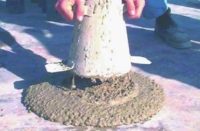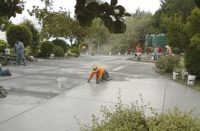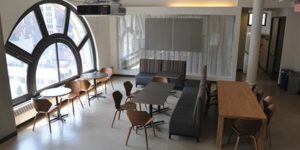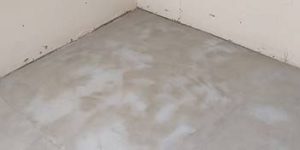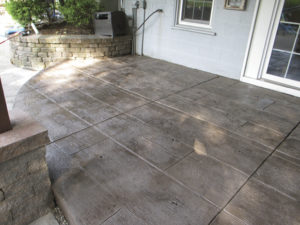
Concrete finishes are typically intended to be smooth — polished even. There are polishing machines and sealants aplenty to achieve that flawless look. Careful selection and use of plywood concrete forms can also influence the finished appearance and texture. Various specialty and textured panels are available.
Overlaid plywood
Plywood panels with an overlay surface are often specified for concrete forms because the overlay yields a smooth surface. Resin-impregnated fiber overlays using phenolic resin and plywood make up the two top choices for concrete form panels: Medium Density Overlay (MDO) and High Density Overlay (HDO). Each of these options results in different finishes and expected reuse durability.
Medium Density Overlay (MDO)
MDO plywood is produced with a resin-impregnated fiber overlay and a minimum of 34 percent phenolic resin content. Manufactured in two grades — concrete form and general — MDO-concrete form panels are less durable (fewer reuses) than HDO-concrete form panels, but significantly outperform plywood concrete form panels manufactured without overlays. The MDO-concrete form panels leave behind a matte finish on the cured concrete surface.
High Density Overlay (HDO)
HDO plywood is produced with a thermosetting resin-impregnated fiber surface (no less than 52 percent phenolic resin) bonded to one or both sides under heat and pressure. The tough resin overlay allows the HDO plywood to resist abrasion, moisture penetration and deterioration from many common chemicals and solvents.
HDO-concrete form panels are the more rugged of the overlaid panels and ideal for such punishing applications as concrete forming. HDO-concrete form panels leave the finished concrete with a smooth “steel-form” finish.
APA-rated siding
APA-rated siding, including 303 plywood siding, is available in a wide variety of surface textures and patterns. When used in concrete formwork, these textures and patterns add beauty and balance to any concrete project, big or small. When a designer considers using texture in a concrete project, it’s often to add visual relief or purposeful pattern to an otherwise monochromatic palette.
Here are six tips from APA — The Engineered Wood Association on how to get your desired finish using engineered wood concrete-forming panels.
Tip 1: Select the right panels for the job
The required plywood class and thickness designation, as well as size and spacing of framing, depends on the maximum load. Concrete form design procedures are based on ACI standard 347, which recognizes the use of many variables in modern concrete designs. These variables include the use of various cement types, admixtures, design slumps and concrete placement systems.
APA provides a Grade-Use Guide for Concrete Forms matrix to make the panel selection easier and more accurate for the job (APA’s Concrete Forming Design/Construction Guide, Form V345, pg. 5, www.performancepanels.com).
Tip 2: Form design considerations
The first step in form design is to determine maximum concrete pressure. It will depend on such things as pour rate, concrete temperature, concrete slump, cement type, concrete density, vibration method and form height.
Textured plywood having an exterior bond classification usually is applied in two ways in formwork design:
- As a liner requiring plywood backing so that the liner delivers texture, but contributes little to the structure of the formwork, or
- As the basic forming panel. In this case, the best reports come from projects where the number of pours required is limited because the textured surface can increase necessary stripping forces and the possibility of damaging the panel while stripping.
Tip 3: Prepare panels for easy stripping
Film coatings — such as lacquer, polyurethane or epoxy — can be used with a release agent to make stripping easier and increase the panels’ life span. A form release agent — applied a few days before the plywood is used, then wiped so a thin film remains — will prolong the life of the plywood form, increase its release characteristics and minimize staining.
Tip 4: Avoid forceful stripping
Metal bars or pry bars shouldn’t be used on plywood because they’ll damage the panel surface and edge. Use wood wedges, tapping gradually when necessary. Plywood’s strength, light weight and large panel size help reduce stripping time. Cross-laminated plywood construction resists edge splitting.
Tip 5: Avoid surface dusting and staining
Surface dusting of concrete has occasionally been seen in concrete poured against a variety of forming materials, including plywood. This could be due to myriad reasons, including excess oil, dirt, dew, smog, unusually hot, dry climactic conditions, and chemical reactions between the form surface and the concrete.
Staining is occasionally observed on concrete poured against HDO plywood forms — a reddish or pinkish stain is a fugitive dye and usually disappears when exposed to sunlight and air. Both these issues can be avoided by properly maintaining form panels.
Tip 6: Caring for APA engineered wood concrete-forming panels
Soon after removal, plywood forms should be inspected for wear, cleaned, repaired, spot primed, refinished and lightly treated with a form-release agent before reusing. Care should be exercised to prevent panel chipping, denting and corner damage during handling. During storage, the stacks of plywood panels should be kept out of the sun and rain, or covered loosely to allow air circulation without heat buildup.

For more information and to create your own impression with APA’s engineered wood concrete-forming panels, visit www.performancepanels.com/concrete-form-panels.
